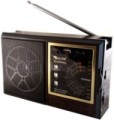Radio
—
FM. The most popular broadcasting range among radio listeners today is primarily due to the fact that the vast majority of music stations broadcast in it. This is due to its features: FM uses frequency modulation, which makes it possible to broadcast sound with a fairly high sound quality, and even in stereo format. In the frequency band, the term "FM" usually refers to the 87.5 MHz to 108 MHz portion of the VHF band, although the range of individual receivers may vary. The disadvantage of FM is the limited range — within the line of sight (up to several tens of kilometers), which has secured the reputation of "urban" stations for FM stations.
— AM. Formally, this designation is not a range, but a type of modulation: "amplitude modulation" — amplitude modulation. In consumer radios, AM most often means the medium wave range of about 520-1610 kHz. Such waves have a propagation range of hundreds of kilometers, but the sound quality in this case is somewhat worse than that of FM, and therefore the AM band is mainly used by radio stations of the “conversational” genre (for example, news or journalistic).
— SW. Broadcasting on short waves (short wave) in the general range from 2.5 MHz to 26.1 MHz, divided into a number of separate sub-bands. Sound quality is average. Short waves are able to reach the opposite side of the Earth, but immediately outside the line of sight of the transmitter, a “dead zone” is formed, several
...tens of kilometers wide. As a consequence, SW is commonly used for overseas broadcasts.
— DAB. Abbreviation for Digital Audio Broadcasting, i.e. "digital broadcasting". This term describes the key difference between this range and those described above: broadcasting in it is carried out not in analogue, but in digital format, the MP2 codec is used for transmission. This gives a number of advantages over traditional transmitters — in particular, a greater range with less power and high quality of the broadcast sound. In addition, this sound is practically not subject to distortion: weak interference does not affect its quality, and when the transmitter power is critically reduced, the signal is not distorted, but disappears entirely. The latter, however, can be written down as disadvantages; but the really significant drawback of this option is perhaps its low prevalence (so far) in the CIS countries. Technically, such broadcasting can be carried out in any band above 30 MHz, but in fact several options are used (depending on the country) related to the VHF band.
— DAB+. An updated and improved version of the DAB standard described above. It has all the characteristic features of digital broadcasting, and differs from its predecessor in higher sound quality at the same bit rates — both due to the use of a different codec (HE-AAC v2), and due to the use of more advanced noise correction algorithms. DAB+ broadcasts cannot be received on DAB receivers: at best, this will require a firmware update, and at worst, you will have to change the receiver itself.Headphone output
A connector for connecting headphones in radio receivers, most often a standard 3.5 mm mini-jack. Headphones can come in handy when the sound from the main speaker might disturb others, or in noisy environments where an external speaker doesn't do well.
Power source
Power supply methods provided in the design of radio receivers and table clocks.
-
Batteries. Powered by standard replaceable batteries (
AA,
AAA,
type C,
LR44,
PP3, etc.). There are two main advantages to this diet. Firstly, a shrunken element can be quickly replaced; for this, of course, you need to have fresh batteries in stock, but it’s easy to take care of this in advance. Secondly, consumer devices are independent of outlets; this allows you to install them on almost any suitable surface, easily move from place to place, without worrying about the length and placement of the mains cable. Batteries, of course, need to be purchased separately, which slightly increases spending. However, many replacement batteries are also available as rechargeable batteries. Thanks to all this, battery-powered models are very popular today.
-
Network. Powered by a standard 230 V network. On the one hand, this option eliminates the hassle of batteries, and on the other hand, connecting to the network is associated with a number of inconveniences: the power cord limits the ability to install a radio or clock in places where there are sockets nearby, moreover the device may interfere or simply not fit into the overall environment. Mai
...ns power in watches is quite rare in its pure form - much more often it is used as a fallback option for battery-powered models: if the situation allows, you can plug the watch into an outlet and not waste the charge.
- Battery. Powered by an original battery that is not related to standard sizes. Like the batteries described above, this option provides the device with autonomy. However, the key difference is that the battery, as a rule, does not provide for quick replacement: a non-standard format makes it difficult to purchase a spare battery, and more often than not, it is generally made non-removable. Therefore, the main, if not the only, option for discharging is charging, which requires a connection to the network and takes quite a long time. As a result, rechargeable batteries are considered a less suitable power option than replacement batteries and are rarely used.
